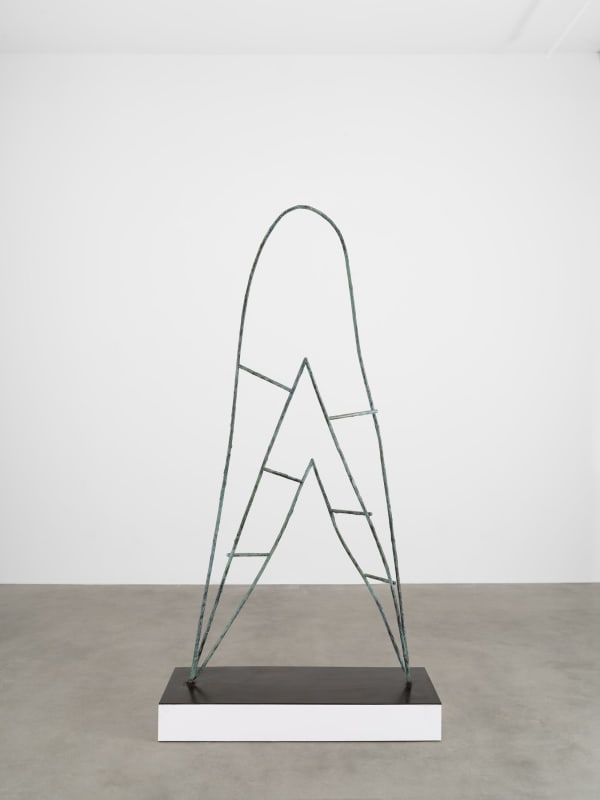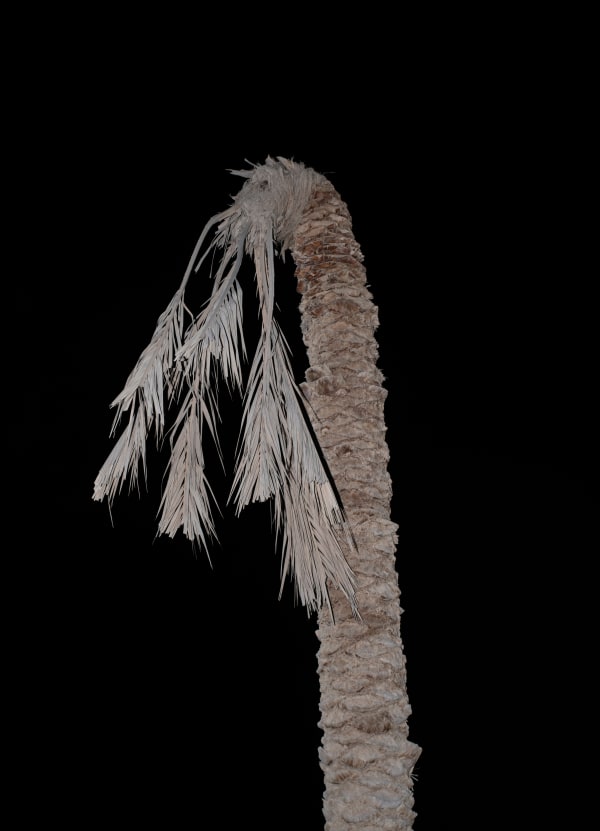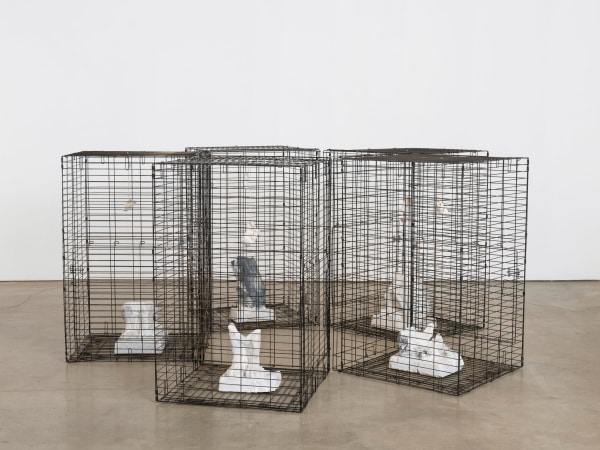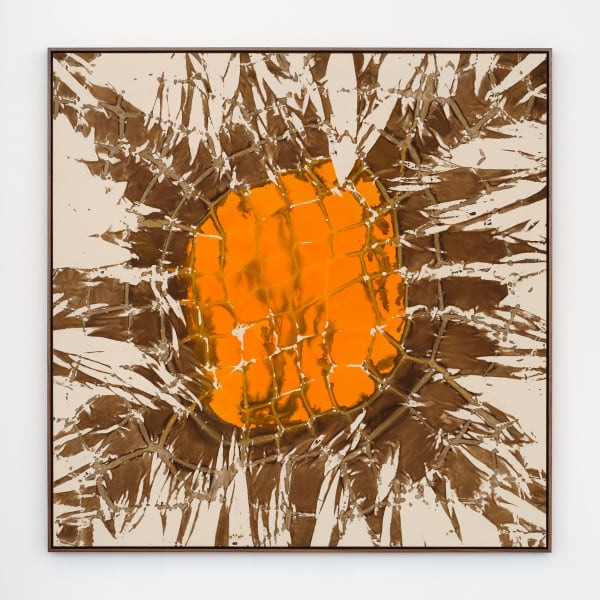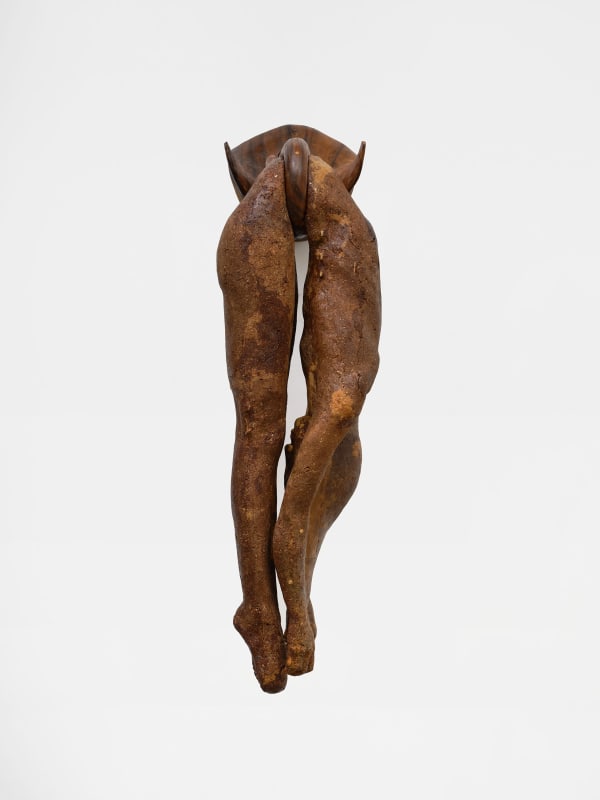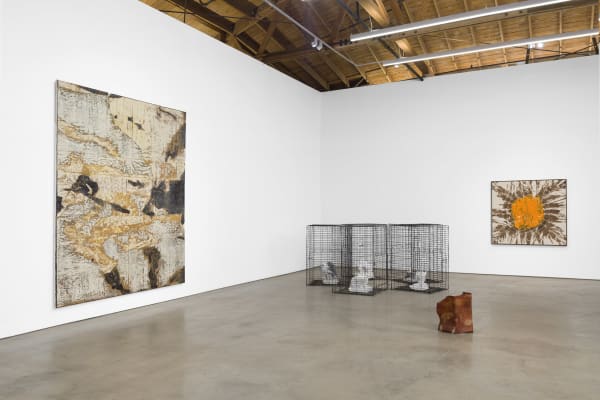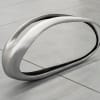Strong Winds Ahead: Group Exhibition
Strong Winds Ahead is a group exhibition that extends a slow and outward escape. The escape begins in an exhausted city—the destination unclear. Encapsulating the middle space between life and death, past and future, and the distinct and imperceptible, the exhibition brings forth the occult, the bestial, and the arcane. The artworks confront human avarice. Insolence, insatiability, and greed leave the land enervated. Calamity is near.
Exhibited across two spaces, participating artists give form to otherwise overlooked forces that compose our world. Harbingers of atrophy: canvas, cotton, bronze, and bone, microplastics, sawdust, and ritual ash foretell trouble ahead. A prayer for safe travel gives partial respite. Dehydration, dilapidation, and collapse portend The End. Strong Winds Ahead impels viewers to proceed with caution and heed the warning signs.
Curated by Lekha Jandhyala
Carlos Agredano (b. 1998, Los Angeles, CA) utilizes readymade and process-based sculptures to materialize issues of race and inequity, particularly within the context of American urban planning systems. Employing toxic, ephemeral, and site- specific material, Agredano’s work exposes how the design and organization of city space perpetuate disparity across Los Angeles. His Collector series, an ongoing project, examines Redlining, a discriminatory practice from the 20th century in which services such as loans and housing are withheld from potential customers on the basis of race and class. The works, like the residents who live in neighborhoods alongside freeways, face high levels of air pollution. Each Collector was installed for exactly one year in Agredano’s childhood home adjacent to the I-105 Freeway in Lynwood. Agredano received his MFA from UCLA in Spring 2023. He
will present a solo exhibition at Human Resources, Los Angeles, in October. He lives and works in Los Angeles.
Monira Al Qadiri (b. 1983, Dakar, Senegal) is renowned for her works across video, sculpture, installation, and performance. Exhibited widely across the globe, Al Qadiri twists tradition and technology to question global capital while complicating world history and geopolitics. In Travel Prayer, a work made in 2014, Al Qadiri uses found footage of a camel race. Slowing down the frame and augmenting the grainy recording with a fuchsia pink filter and an electronic score, she enhances the eerie but mesmerizing spectacle. On the backs of the camels, remote-controlled whipping machines replace what used to be child camel jockeys. Her work questions ethical, technological, financial, and environmental acceleration. Her first institutional solo exhibition in China, Haunted Water is currently on view at UCCA Dune until October. Earlier this year, she presented her solo exhibition Mutant Passages at the Kunsthaus Bregenz in Austria. Her previous solo exhibitions have been held at the Guggenheim Museum Bilbao (2022) and Haus der Kunst, Munich, Germany (2020). She has been featured in group exhibitions at the 59th Venice Biennale (2022); Palais de Tokyo, Paris, France (2020); MoMA PS1, New York (2019); the 6th Athens Biennial (2018); the 9th Asia Pacific Triennial (2018); and the Jameel Arts Center, Dubai, United Arab Emirates (2018). She lives and works in Berlin.
Farah Al Qasimi (b.1991, Abu Dhabi, United Arab Emirates) blends architecture, interiors, animation, advertisements, and nature in futuristic, sometimes kitsch, photographic compositions that confront global consumer culture. In Bahia Palm, a droopy palm suggests a tired body and an exhausted existence. This year alone, Al Qasimi presented solo exhibitions at the Art Gallery of Western Australia, as well as at C/O Berlin and Mast Foundation in Bologna, Italy. She participated in several group presentations at SFMOMA, MCA San Diego, and LACMA and expanded her multidisciplinary practice to new global audiences at the Sharjah Biennial 15, the Gwangju Biennale 14, and the Triennial for Photography and New Media in Norway. This October, she will be a part of the Guggenheim New York exhibition Going Dark: The Contemporary Figure at the Edge of Visibility. She lives and works in Brooklyn.
Ragini Bhow (b. 1991, Minneapolis, MN) fosters deep seeing through paintings and sculptures that have lives, spirits, and strengths of their own. In Strong Winds Ahead, she presents vibrational paintings and a floor sculpture that holds commanding and deep-rooted animism. Bhow’s work speaks to the microbial, psychoactive, cosmic, and supernatural. Using materials such as hand-made pigments and ritual ash, she explores different temporalities and materialities to illustrate the shiftiness of recollection through her ritualistic processes. Recently she presented a solo exhibition at Tiger Strikes Asteroid, New York, and participated in group exhibitions at Jack Barrett Gallery and Charles Moffett Gallery this summer. Raised in Bangalore, she has exhibited across India and Europe. Her previous group exhibitions include: Kleine- Humboldt Galerie, Berlin; Galerie Mirchandani & Steinruecke, Mumbai, India; UNM Art Museum, Albuquerque; and Gallery SKE, Bangalore, India. She completed a residency at KHOJ, New Delhi, in 2014. She lives and works in New York.
Sayre Gomez (b. 1982, Chicago, IL) centers Los Angeles as the primary subject of his paintings, deploying a range of techniques that capture the city’s textural and sprawling topography. A felt tension creeps throughout Gomez’s urban depictions, alluding to obverse heterotopias of sunshine and noir that can be found in the details of the city’s infrastructure and detritus of industries past—often set against sublime sunsets. His solo exhibition, Landscapes, is currently on view at Galerie Nagel Draxler, Cologne, Germany. Recent solo exhibitions were presented at the Sifang Art Museum, Nanjing, China; Fondazione Sandretto Re Rebaudengo, Turin, Italy; and at François Ghebaly, Los Angeles. Last year he participated in group exhibitions at mumok, Vienna, Austria; Aishti Foundation, Beirut, Lebanon; Art Gallery of New South Wales, Sydney, Australia; Institute of Contemporary Art, Miami; and Kranzberg Art Foundation, St. Louis. The artist lives and works in Los Angeles.
Camille Henrot (b. 1978, Paris, France) has spent the past two decades developing a critically acclaimed practice that encompasses drawing, painting, sculpture, installation, and film. Her work captures the complexity of navigating an oversaturated world and is often inspired by literature, poetry, cartoons, social media, and the mundane. For Strong Winds Ahead, Henrot presents two exquisite bronze sculptures. Mon Corps de femme depicts a languid form, where the sweeping curves of convex and concave shapes reveal the contours of a sagging belly and breasts. Amma’s Door, in contrast, suggests a sense of teenage-like vitality and resembles a mountain in mid-stride. With accolades such as the 55th Venice Biennale Silver Lion, Nam June Paik Award, and the Edvard Munch Award, Henrot has established herself as a preeminent artist. She lives and works in New York.
Shana Hoehn (b. 1991, Texarkana, TX) engages with gendered objects and gestures within Western iconography. Held high by the serpentine neck of a bird, a draped body intercepts the entrance to the first gallery space of the show. The title of this work, Pike, references a cheerleading jump in which the body is similarly folded. This oscillation of a gesture that can appear as passive and active is a recurring theme in Hoehn’s work. Through meticulous processes, including carving, casting, and 3D printing, she crafts hybrid forms using metals and wood. Hoehn received her MFA in Sculpture and Extended Media at Virginia Commonwealth University and BFA in Painting at Maryland Institute College of Art. She has participated in several residencies and fellowships, including the AIR Program at Artpace San Antonio, the Jan Van Eyck Academie, the Core Program at the Museum of Fine Arts Houston, Skowhegan School of Painting and Sculpture, SOMA Summer, and a Fulbright Research Fellowship. Recent solo exhibitions have been at Prairie, Chicago, IL (2022), Make Room, Los Angeles, CA (2022); Art Pace, San Antonio, TX (2022); Euqinom Gallery, San Francisco, CA (2021). Her work has been included in group presentations with Simon Lee Gallery, London (2022); The Blaffer Museum in Houston, TX (2022); Contemporary Art Museum Houston in Houston, TX (2020-21); P. Bibeau, New York, NY (2022); Lodos Gallery, Mexico City (2021). A Summer. Hoehn lives and works in Los Angeles.
iris yirei hu (b.1991, Los Angeles, CA) is a multidisciplinary artist. In the form of paintings, installations, and public artworks, her works reveal connections within a landscape, including its inhabitants, ecologies, traditions, stories, and spirits. She approaches her art-making as relational—between plants, places, and people— and acknowledges the specificity and context from which her work’s materials and craft techniques are derived. The process of sourcing and transforming materials into botanical pigments, dyes, textiles, and other materials is an integral part of hu’s work. She has exhibited her work at institutions such as the Armory Center for the Arts, Pasadena; Center for Arts, Research, and Alliances (CARA); MOCA Tucson; John Michael Kohler Arts Center; and Los Angeles Municipal Art Gallery; among others. She has completed public art commissions for California State University, Dominguez Hills; Institute of Contemporary Art, Los Angeles (ICA- LA) and Los Angeles Nomadic Division (LAND); LA County Department of Mental Health; and LA Metro. In 2022, she was awarded the Fellowship for Visual Artists from the California Community Foundationand selected as an artist-in-residence at Headlands Center for the Arts. She completed her BA from UCLA and MFA from Columbia University. She lives and works in Los Angeles.
Rindon Johnson (b. 1990, San Francisco, CA) works across numerous modes, from virtual reality and sculpture to poetry and art criticism. Questions of embodiment and technology weave throughout his work: What does skin remember? Johnson’s materials are carefully considered, building on the notion of the by-product and calling on histories of colonial exploitation and slavery. Using dynamic processes like aging, staining, and exposure to the elements, he encodes time and place as both materials and collaborators. With candid, sharp-edged humor, Johnson’s practice balances playful experimentation with a stark examination of intimacy and violence. He has presented solo exhibitions at Chisenhale Gallery, London; The Julia Stoschek Collection, Düsseldorf; and the SculptureCenter, New York. Johnson has participated in group exhibitions at the Brooklyn Museum, Kunstverein Freiburg, The Hammer Museum, The Whitney Museum, The Studio Museum in Harlem, Literaturhaus Berlin, Haus der elektronischen Künste, Basel among others. He is the author of Nobody Sleeps Better Than White People (Inpatient, 2016), the VR book, Meet in the Corner (Publishing- House.Me, 2017), Shade the King (Capricious, 2017) and The Law of Large Numbers: Black Sonic Abyss (Chisenhale, Inpatient, SculptureCenter 2021). He was born on the unceded territories of the Ohlone people. Johnson currently lives and works in Berlin.
Maia Ruth Lee (b.1983, Busan, South Korea) is deeply informed by questions surrounding the self in times of dispersion, mobility, and rootlessness. Her multidisciplinary practice spans photography, video, painting, and sculpture and uses translation as an apparatus. Connecting themes of borders, community, and language, her work embodies self-preservation and migration through process and materials. Lee has held solo exhibitions at the Museum of Contemporary Art Denver, François Ghebaly Los Angeles, and Tina Kim Gallery, New York, and has participated in numerous group exhibitions, including the Aspen Art Museum (2022) and the Whitney Biennial at the Whitney Museum of American Art (2019). She holds degrees from Hongik University in Seoul and the Emily Carr Institute of Art and Design in Vancouver, Canada. Lee lives and works in Salida, Colorado.
Vijay Masharani (b. 1995 Bay Area, CA) is a multidisciplinary artist who works across video, writing, and drawing. By augmenting and collaging his own footage, he coaxes out latent power dynamics subtending everyday life, with a particular interest in the structuring social abstractions of race and nation. His work operates in a realm of playful aloofness, paranoia, and urgency to supercharge vernacular scenes. His disconcerting approach, using auditory repetition, animation, choppy cuts, and humor, provokes a momentary cognitive scattering in the viewer. He is currently attending the Skowhegan School of Painting and Sculpture and, in 2022, completed his MA in Race, Ethnicity, and Postcolonial Studies at University College London (UCL). Select solo and two-person exhibitions include: hatred 2, Brooklyn, NY (2023); Clima, Milan, Italy (2021); and Museum Gallery, New York (2019). Recent group exhibitions include: JUF Project, Madrid, Spain (2023); Center for Experimental Lectures, Halle für Kunst, Lüneburg, Germany (2022); and Helena Anrather, New York (2021) among others. Masharani is based in New York.
Harold Mendez (b. 1977, Chicago, IL)'s Jaulas (2017) is a grouping of worn animal cages arranged in a circular composition. Each cage holds various fragments of stone animal statues and suspended bones — remnants of a beast or guardian. His work has been the subject of solo exhibitions at the Wexner Center for the Arts, Columbus (2023); Commonwealth and Council, Los Angeles, (2023); Institute of Contemporary Art, Miami (2021); Institute for Contemporary Art at VCU, Richmond (2021); Institute of Contemporary Art, Los Angeles (2020); and the Reva and David Logan Center for the Arts, University of Chicago (2020) among others. He has participated in significant exhibitions, including Being: New Photography 2018 at the Museum of Modern Art, New York, and the 2017 Whitney Biennial, New York. He has been an artist-in-residence at the Center for Contemporary Ceramics (2023); the John Michael Kohler Arts Center (2021); Light Work (2020); Cross Currents Artist Exchange through the John D. and Catherine T. MacArthur Foundation International Connections Initiative, Havana, Cuba (2017); Robert Rauschenberg Foundation (2016); Headlands Center for the Arts (2014, 2012); Core Program, The Museum of Fine Arts, Houston (2014, 2015); and Skowhegan School of Painting and Sculpture (2013). His works are included in the permanent collections of the Whitney Museum of American Art; Walker Art Center; Studio Museum in Harlem; Minneapolis Institute of Art; and the Museum of Fine Arts, Houston.
Eli Ping (b. 1977, Chicago, IL) creates work that embodies themes of imminence and intangibility, exploring the delicate boundary between life and death. His looming yet delicate sculpture Monocarp carries an off-white, skin-like surface that evokes conflicting senses of the animate and the deadened. Ping has exhibited extensively across the United States and Europe, including recent solo exhibitions at Maria Bernheim, Zürich and, ANDNOW, Dallas (2022). In 2023, he has participated in a number of group exhibitions including Triest, New York; Jack Siebert Projects, Los Angeles; and Cooper Brovenick, New York. Ping lives and works in Brooklyn, New York.
Edgar Ramirez (b. 1989, Los Angeles, CA) combines cardboard and house paint in his titanic paintings. Through a meticulous process of layering and tearing, he blurs the boundaries between décollage and urban decay, resulting in visually striking artworks like Tamarack (2023), a newly commissioned work that echoes both the size and texture of refineries, twisting smoke, and cargo containers often seen along the California coast. Ramirez holds an MFA from Art Center College of Design, Pasadena, and a BFA from Otis College of Art and Design, Los Angeles. His work has been showcased in exhibitions across the US, including notable presentations at Lisson Gallery in New York (2023) and The Mistake Room in Los Angeles (2022). He lives and works in Los Angeles.
Molly Segal (b. 1983, Oakland, CA) is a Los Angeles-based painter. Taking California as her central subject, Segal delves into the price of survival in the face of limited resources and harsh environments. Her watercolor paintings, most notably depicting wildfires, landfills, construction sites, whale carcasses, and dead honeybees, allude to human overconsumption and decadence. My Sweetest Friend, made this year, departs from Segal’s usual pastel and gem-toned palette. In this vigorously painted work of an animal carcass, an indistinguishable aggregate of bones, fur, and skin takes shape against a sun-baked desert floor. Segal’s work has been exhibited at Charlie James Gallery, the Museum of Fine Arts, Boston, and Zevitas Marcus Gallery. She received her MFA from the School of the Museum of Fine Arts at Tufts University in 2013. She lives and works in Los Angeles.
Andrew Sendor (b.1977, New York, NY) meticulously renders photorealistic, monochromatic paintings that portray psychologically charged narratives. In his work, the interplay of piercing sunlight from open skies and the darkness of a dusty interior creates a visual tension symbolizing the juxtaposition of possibilities and constraints. His works have been included in numerous group and museum exhibitions, including the Nassau County Museum of Art, NY; Funen Art Museum, Odense, Denmark; Hudson Valley MOCA, Peekskill, NY; Knoxville Museum of Art, Knoxville, TN; Kemper Museum of Contemporary Art, Kansas City, MO; and the ARKEN Museum of Art, Ishøj, Denmark. He lives and works in New York.
April Street (b. 1975, Garden, Virginia) blends natural scenery with bodily components to create surreal formations of undiscoverable terrains. Undulating curves and sprouting plant life shape the environment, while unearthly figurations emerge within her multifaceted paint and textile canvases. Inspired by feminist art practices of the 60s and 70s, Street incorporates nylon hosiery to expand the boundaries of painting, intertwining historical and literary narratives. Street studied bronze casting in central Italy and painting at The School of the Art Institute of Chicago. Her recent exhibitions include Santa Barbara Museum of Art; and in Los Angeles: Vielmetter; Maccarone; LAXART; Various Small Fires; Carter & Citizen; and The Underground Museum. She is a grant recipient of the National Endowment for the Arts. She lives and works in Los Angeles.
Gray Wielebinski (b. 1991 Dallas, TX) explores the intersections of mythology, identity, gender, and surveillance to challenge societal frameworks and belief systems. Drawing inspiration from ancient and contemporary myths, he reconfigures iconography to propose alternative narratives. With a focus on the mythologizing of Texas and the influence of Hollywood in Los Angeles, Wielebinski interrogates power dynamics and invites viewers to examine their relationship with familiar objects, such as spikes and spurs or barbed wire. Here, his works are ominous and sinister whilst maintaining a cartoonish and devilishly cute quality reminiscent of childhood animations. He received a BA from Pomona College in 2014 before completing an MFA from the Slade School of Fine Art in 2018. In September, the ICA London will present Wielebinski’s first solo institutional exhibition, The Red Sun is High, the Blue Low. His work has been exhibited in solo exhibitions at 12.26 Gallery in Los Angeles and Dallas, and Hales Gallery in London and in group shows at the Goldsmiths Centre for Contemporary Art; Bold Tendencies; and V.O Curations in London. He lives and works in both London and Los Angeles. exhibited in solo exhibitions at 12.26 Gallery in Los Angeles and Dallas, and Hales Gallery in London and in group shows at the Goldsmiths Centre for Contemporary Art; Bold Tendencies; and V.O Curations in London. He lives and works in both London and Los Angeles.
-
 Shana Hoehn, Pike, 2023
Shana Hoehn, Pike, 2023 -
 Molly Segal, My Sweetest Friend, 2023
Molly Segal, My Sweetest Friend, 2023 -
 April Street, There are Holes in the Sky, 2023
April Street, There are Holes in the Sky, 2023 -
![April Street, Conforms #2 [Return to Wandering Limbs], 2023](data:image/gif;base64,R0lGODlhAQABAIAAAAAAAP///yH5BAEAAAAALAAAAAABAAEAAAIBRAA7) April Street, Conforms #2 [Return to Wandering Limbs], 2023
April Street, Conforms #2 [Return to Wandering Limbs], 2023 -
 Camille Henrot, Amma's Door, 2014
Camille Henrot, Amma's Door, 2014 -
 Carlos Agredano, Collector, 2020
Carlos Agredano, Collector, 2020 -
 Carlos Agredano, Collector, 2021
Carlos Agredano, Collector, 2021 -
 Carlos Agredano, Collector, 2022
Carlos Agredano, Collector, 2022 -
 Ragini Bhow, Bones left behind, 2023
Ragini Bhow, Bones left behind, 2023 -
 Ragini Bhow, Old echo, 2023
Ragini Bhow, Old echo, 2023 -
 Iris Yirei Hu, lumen, 2023
Iris Yirei Hu, lumen, 2023 -
 Iris Yirei Hu, float, 2023
Iris Yirei Hu, float, 2023 -
 Iris Yirei Hu, pearl, 2023
Iris Yirei Hu, pearl, 2023 -
 Gray Wielebinski, Spurs and Spikes, 2023
Gray Wielebinski, Spurs and Spikes, 2023 -
 Farah Al Qasimi, Bahia Palm, 2019
Farah Al Qasimi, Bahia Palm, 2019 -
 Vijay Masharani, Give me that fucking content, Universe, 2023
Vijay Masharani, Give me that fucking content, Universe, 2023 -
 Andrew Sendor, Solvej and Casparina on the Arnarulunnquaq Vessel, 2022
Andrew Sendor, Solvej and Casparina on the Arnarulunnquaq Vessel, 2022 -
 Eli Ping, Monocarp, 2023
Eli Ping, Monocarp, 2023 -
 Sayre Gomez, Monument, 2022
Sayre Gomez, Monument, 2022 -
 Edgar Ramirez, Tamarack, 2023
Edgar Ramirez, Tamarack, 2023 -
 Rindon Johnson, With what eyes did you make that mountain and in what winter were you undone?, 2021
Rindon Johnson, With what eyes did you make that mountain and in what winter were you undone?, 2021 -
 Harold Mendez, Jualas, 2017
Harold Mendez, Jualas, 2017 -
 Maia Ruth Lee, B.B.M 1-19 Brown with Marigold Center, 2023
Maia Ruth Lee, B.B.M 1-19 Brown with Marigold Center, 2023 -
 Monira Al Qadiri, Travel Prayer, 2014
Monira Al Qadiri, Travel Prayer, 2014




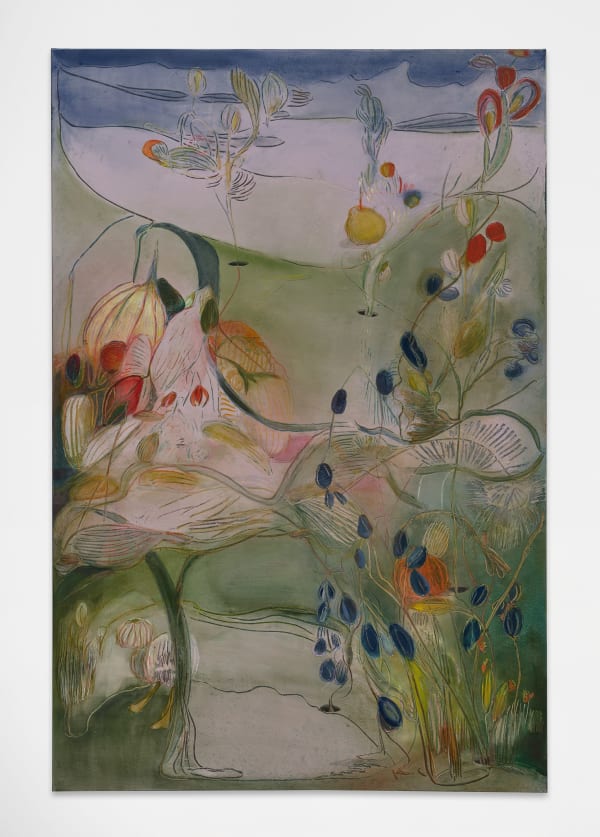
![April Street, Conforms #2 [Return to Wandering Limbs], 2023](https://artlogic-res.cloudinary.com/w_600,c_limit,f_auto,fl_lossy,q_auto/artlogicstorage/ghebaly/images/view/81e1d84b054a456a80f096e81dc88594j/fran-oisghebaly-april-street-conforms-2-return-to-wandering-limbs-2023.jpg)
